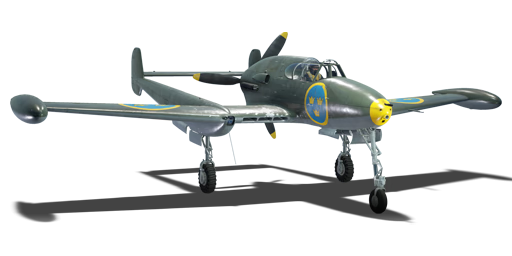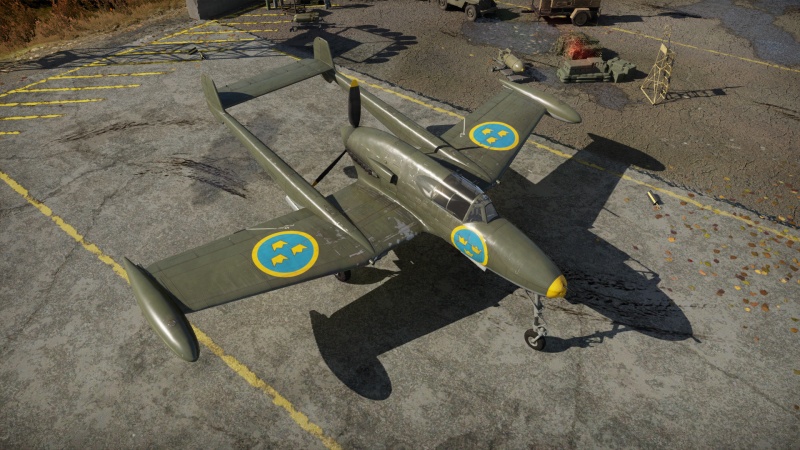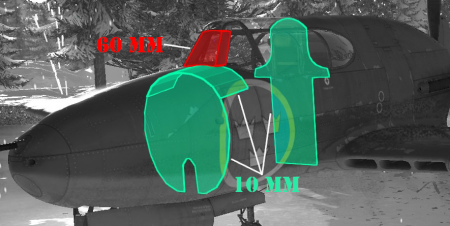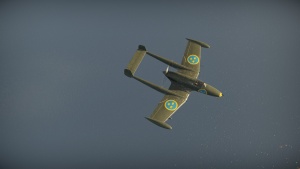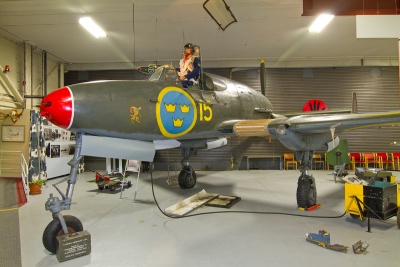Difference between revisions of "A21A-3"
Colok76286 (talk | contribs) (Edits) |
(→Suspended armament: Added custom loadouts) |
||
| (18 intermediate revisions by 7 users not shown) | |||
| Line 16: | Line 16: | ||
== General info == | == General info == | ||
=== Flight performance === | === Flight performance === | ||
| − | |||
{{Specs-Avia-Flight}} | {{Specs-Avia-Flight}} | ||
| + | <!-- ''Describe how the aircraft behaves in the air. Speed, manoeuvrability, acceleration and allowable loads - these are the most important characteristics of the vehicle.'' --> | ||
| − | The A21A-3 has a poor climb rate and fairly low acceleration, making it ineffective as an energy or boom-and-zoom fighter unless you commit to a side climb. The aircraft has great turning characteristics at almost all speeds, and maintains speed in horizontal turns well enough, though it will stall quickly in any vertical manoeuvres. The aircraft maintains most of its turning ability with heavy loads, but suffers greatly in climb ability. If you wish to take an altitude advantage, forgo any loads. | + | The A21A-3 has a poor climb rate and fairly low acceleration, making it ineffective as an energy or boom-and-zoom fighter unless you commit to a side climb. The aircraft has great turning characteristics at almost all speeds, and maintains speed in horizontal turns well enough, though it will stall quickly in any vertical manoeuvres. The aircraft maintains most of its turning ability with heavy loads, but suffers greatly in climb ability. If you wish to take an altitude advantage, forgo any loads. |
{| class="wikitable" style="text-align:center" width="70%" | {| class="wikitable" style="text-align:center" width="70%" | ||
| Line 76: | Line 76: | ||
=== Survivability and armour === | === Survivability and armour === | ||
| + | {{Specs-Avia-Armour}} | ||
| + | <!-- ''Examine the survivability of the aircraft. Note how vulnerable the structure is and how secure the pilot is, whether the fuel tanks are armoured, etc. Describe the armour, if there is any, and also mention the vulnerability of other critical aircraft systems.'' --> | ||
[[File:J21 Armour Plating.png|450px|thumb|right|Protective components found in the '''{{PAGENAME}}'''.]] | [[File:J21 Armour Plating.png|450px|thumb|right|Protective components found in the '''{{PAGENAME}}'''.]] | ||
| − | |||
| − | |||
* 10 mm steel - Firewall armour plate | * 10 mm steel - Firewall armour plate | ||
| Line 84: | Line 84: | ||
* 10 mm steel - Pilot's back armour plate | * 10 mm steel - Pilot's back armour plate | ||
* 60 mm bulletproof glass | * 60 mm bulletproof glass | ||
| + | * Engine fire system (EFS) | ||
=== Modifications and economy === | === Modifications and economy === | ||
| Line 100: | Line 101: | ||
|} | |} | ||
=== Offensive armament === | === Offensive armament === | ||
| + | {{Specs-Avia-Offensive}} | ||
<!-- ''Describe the offensive armament of the aircraft, if any. Describe how effective the cannons and machine guns are in a battle, and also what belts or drums are better to use. If there is no offensive weaponry, delete this subsection.'' --> | <!-- ''Describe the offensive armament of the aircraft, if any. Describe how effective the cannons and machine guns are in a battle, and also what belts or drums are better to use. If there is no offensive weaponry, delete this subsection.'' --> | ||
| − | |||
{{main|Akan m/45 (20 mm)|Akan m/39A (13.2 mm)}} | {{main|Akan m/45 (20 mm)|Akan m/39A (13.2 mm)}} | ||
| Line 112: | Line 113: | ||
=== Suspended armament === | === Suspended armament === | ||
| + | {{Specs-Avia-Suspended}} | ||
<!-- ''Describe the aircraft's suspended armament: additional cannons under the wings, bombs, rockets and torpedoes. This section is especially important for bombers and attackers. If there is no suspended weaponry remove this subsection.'' --> | <!-- ''Describe the aircraft's suspended armament: additional cannons under the wings, bombs, rockets and torpedoes. This section is especially important for bombers and attackers. If there is no suspended weaponry remove this subsection.'' --> | ||
| − | |||
| − | {{ | + | The '''''{{PAGENAME}}''''' can be outfitted with the following ordnance: |
| − | |||
| − | + | {| class="wikitable" style="text-align:center" width="100%" | |
| + | |- | ||
| + | ! !! width="4%" | 1 !! width="4%" | 2 !! width="4%" | 3 !! width="4%" | 4 !! width="4%" | 5 !! width="4%" | 6 !! width="4%" | 7 !! width="4%" | 8 !! width="4%" | 9 !! width="4%" | 10 !! width="4%" | 11 | ||
| + | | rowspan="9" width="30%" | <!-- <div class="ttx-image">[[File:Hardpoints_{{PAGENAME}}.png]]</div> --> | ||
| + | |- | ||
| + | ! [[sb m/47 (50 kg)|50 kg sb m/47]] bombs | ||
| + | | || || || || 2 || || 2 || || || || | ||
| + | |- | ||
| + | ! [[mb m/40 (250 kg)|250 kg mb m/40]] bombs | ||
| + | | || || || || || 1 || || || || || | ||
| + | |- | ||
| + | ! [[mb m/41 (500 kg)|500 kg mb m/41]] bombs | ||
| + | | || || || || || 1 || || || || || | ||
| + | |- | ||
| + | ! [[mb m/50 (600 kg)|600 kg mb m/50]] bombs | ||
| + | | || || || || || 1 || || || || || | ||
| + | |- | ||
| + | ! [[hprak m/49]] rockets | ||
| + | | || || 1 || || || || || || 1 || || | ||
| + | |- | ||
| + | ! [[psrak m/49B]] rockets | ||
| + | | 1 || 1 || 1 || 1 || || || || 1 || 1 || 1 || 1 | ||
| + | |- | ||
| + | ! [[srak m/51]] rockets | ||
| + | | 1 || 1 || 1 || 1 || || || || 1 || 1 || 1 || 1 | ||
| + | |- | ||
| + | | colspan="12" | Maximum permissible loadout weight: 750 kg<br>Maximum permissible weight imbalance: 260 kg | ||
| + | |- | ||
| + | | colspan="13" | * Rockets and bombs cannot be equipped simultaneously | ||
| + | |- | ||
| + | |} | ||
| + | {{Navigation-Start|Default weapon presets}} | ||
| + | {{Navigation-First-Simple-Line}} | ||
* Without load | * Without load | ||
| + | * 8 x psrak m/49B rockets | ||
| + | * 8 x srak m/51 rockets | ||
| + | * 2 x hprak m/49 rockets | ||
* 4 x 50 kg sb m/47 bombs (200 kg total) | * 4 x 50 kg sb m/47 bombs (200 kg total) | ||
* 1 x 250 kg mb m/40 bomb (250 kg total) | * 1 x 250 kg mb m/40 bomb (250 kg total) | ||
| − | |||
* 1 x 500 kg mb m/41 bomb (500 kg total) | * 1 x 500 kg mb m/41 bomb (500 kg total) | ||
* 1 x 600 kg mb m/50 bomb (600 kg total) | * 1 x 600 kg mb m/50 bomb (600 kg total) | ||
| − | + | {{Navigation-End}} | |
| − | |||
| − | |||
| − | |||
| − | |||
| − | |||
== Usage in battles == | == Usage in battles == | ||
| − | <!--Describe the tactics of playing in the aircraft, the features of using aircraft in a team and advice on tactics. Refrain from creating a "guide" - do not impose a single point of view, but instead, give the reader food for thought. Examine the most dangerous enemies and give recommendations on fighting them. If necessary, note the specifics of the game in different modes (AB, RB, SB).--> | + | <!-- ''Describe the tactics of playing in the aircraft, the features of using aircraft in a team and advice on tactics. Refrain from creating a "guide" - do not impose a single point of view, but instead, give the reader food for thought. Examine the most dangerous enemies and give recommendations on fighting them. If necessary, note the specifics of the game in different modes (AB, RB, SB).'' --> |
Boasting extremely good turning characteristics, a stable platform, decent speed and accurate, powerful guns, the A21A-3 is an extremely effective aircraft for both dogfighting and ground attack duties. The Swedish 13.2 mm Akan m/39A guns are devastating to lighter aircraft thanks to their anti-air belts with plentiful HE, and the nose mounted 20 mm cannon makes short work of larger targets as long as you are accurate. In air-to-air battles, the aircraft is best suited to catch opponents low on energy. Only a few aircraft at its BR are able to turn as well as the A21A-3 at low altitude, and the aircraft remains stable even in low speed turns to keep guns on target. It is wise to keep fights short though, as the A21A-3 is a terrible climber, and is an easy target for boom and zoom fighters if engaged in a fight. | Boasting extremely good turning characteristics, a stable platform, decent speed and accurate, powerful guns, the A21A-3 is an extremely effective aircraft for both dogfighting and ground attack duties. The Swedish 13.2 mm Akan m/39A guns are devastating to lighter aircraft thanks to their anti-air belts with plentiful HE, and the nose mounted 20 mm cannon makes short work of larger targets as long as you are accurate. In air-to-air battles, the aircraft is best suited to catch opponents low on energy. Only a few aircraft at its BR are able to turn as well as the A21A-3 at low altitude, and the aircraft remains stable even in low speed turns to keep guns on target. It is wise to keep fights short though, as the A21A-3 is a terrible climber, and is an easy target for boom and zoom fighters if engaged in a fight. | ||
| − | On the other hand, the A21A-3 makes for an extremely effective ground-and-pound aircraft, capable of destroying an enemy base with its 600 kg bomb in some air RB game modes, access to some of the best rockets weight-for-weight at its battle rating, and a significant amount of ammunition for its guns to attack ground units. The aircraft's low speed stability makes short dipping attack runs on ground units easy, and the good firepower means you don't have to stay on target for too long. | + | On the other hand, the A21A-3 makes for an extremely effective ground-and-pound aircraft, capable of destroying an enemy base with its 600 kg bomb in some air RB game modes, access to some of the best rockets weight-for-weight at its battle rating, and a significant amount of ammunition for its guns to attack ground units. The aircraft's low speed stability makes short dipping attack runs on ground units easy, and the good firepower means you don't have to stay on target for too long. |
| − | + | The quad 13.2 mm machine guns get access to high-explosive rounds, which are very potent when attacking smaller ground targets, such as Howitzers, AA and armoured cars, often requiring a very short burst to take care of them. The 20 mm cannon is able to destroy light pillboxes. However, quite large bursts are required to take them down. | |
| − | In ground RB, the aircraft can perform well at almost any BR, as its 600 kg bomb can be used effectively to clear points and entrenched enemy tanks of any size with a whopping 18 m destruction range, with a fighter's SP cost it can be an invaluable CAS asset to a team. | + | It is important to take care that enemy aircraft do not get a chance to attack you from behind, however. The A21A-3, as a pusher aircraft, can be brought down quickly when tailed. The engine is poorly armoured, with a tiny water and oil reserve and runs at a high temperature. Additionally, there is a fuel tank between the cockpit and engine which will not survive even a glancing hit. If you are attacked and suffer an oil or water leak you will need to land at your base as quickly as possible, the engine will burn out within minutes of an overheat. The large control surface of the tail is also a vulnerability. |
| + | |||
| + | In ground RB, the aircraft can perform well at almost any BR, as its 600 kg bomb can be used effectively to clear points and entrenched enemy tanks of any size with a whopping 18 m destruction range, with a fighter's SP cost it can be an invaluable CAS asset to a team. | ||
[[File:A21A-3 flying over a body of water.jpg|thumb|A21A-3 flying]] | [[File:A21A-3 flying over a body of water.jpg|thumb|A21A-3 flying]] | ||
| Line 173: | Line 204: | ||
* Armed with extremely powerful 13.2 mm guns with decent ammunition pool and destructive AA belts | * Armed with extremely powerful 13.2 mm guns with decent ammunition pool and destructive AA belts | ||
* Access to powerful and accurate rockets and devastating bombs for ground RB | * Access to powerful and accurate rockets and devastating bombs for ground RB | ||
| − | * 600 kg bomb can destroy an enemy base in some air RB game modes | + | * 600 kg bomb can destroy an enemy base in some air RB game modes |
| + | * Has CCRP for bombs, very rare feature at his BR | ||
'''Cons:''' | '''Cons:''' | ||
| Line 182: | Line 214: | ||
* Loses speed in vertical manoeuvres extremely quickly | * Loses speed in vertical manoeuvres extremely quickly | ||
* Lacks airbrake | * Lacks airbrake | ||
| − | * Fragile and vulnerable from rear attacks, even water or oil leaks will tend to cause the aircraft to crash as the engine burns out quickly. | + | * Fragile and vulnerable engine from rear attacks, even water or oil leaks will tend to cause the aircraft to crash as the engine burns out quickly. |
* Engine overheats quickly when on WEP | * Engine overheats quickly when on WEP | ||
| Line 204: | Line 236: | ||
;Skins | ;Skins | ||
| + | |||
* [https://live.warthunder.com/feed/camouflages/?vehicle=saab_a21a_3 Skins and camouflages for the {{PAGENAME}} from live.warthunder.com.] | * [https://live.warthunder.com/feed/camouflages/?vehicle=saab_a21a_3 Skins and camouflages for the {{PAGENAME}} from live.warthunder.com.] | ||
| Line 215: | Line 248: | ||
;Related development | ;Related development | ||
| + | |||
* [[J21 (Family)]] | * [[J21 (Family)]] | ||
;Aircraft of comparable role, configuration and era | ;Aircraft of comparable role, configuration and era | ||
| + | |||
* [[SM.91]] | * [[SM.91]] | ||
* [[SM.92]] | * [[SM.92]] | ||
Latest revision as of 07:18, 26 August 2024
| This page is about the Swedish fighter A21A-3. For other versions, see J21 (Family). |
Contents
Description
The A21A-3 is a rank IV Swedish fighter with a battle rating of 5.3 (AB), 4.3 (RB), and 3.7 (SB). It was introduced in Update 1.95 "Northern Wind".
General info
Flight performance
The A21A-3 has a poor climb rate and fairly low acceleration, making it ineffective as an energy or boom-and-zoom fighter unless you commit to a side climb. The aircraft has great turning characteristics at almost all speeds, and maintains speed in horizontal turns well enough, though it will stall quickly in any vertical manoeuvres. The aircraft maintains most of its turning ability with heavy loads, but suffers greatly in climb ability. If you wish to take an altitude advantage, forgo any loads.
| Characteristics | Max Speed (km/h at 4,300 m) |
Max altitude (metres) |
Turn time (seconds) |
Rate of climb (metres/second) |
Take-off run (metres) | |||
|---|---|---|---|---|---|---|---|---|
| AB | RB | AB | RB | AB | RB | |||
| Stock | 616 | 599 | 10800 | 21.0 | 21.9 | 12.6 | 12.6 | 300 |
| Upgraded | 666 | 640 | 19.0 | 20.0 | 19.0 | 15.5 | ||
Details
| Features | ||||
|---|---|---|---|---|
| Combat flaps | Take-off flaps | Landing flaps | Air brakes | Arrestor gear |
| ✓ | ✓ | ✓ | X | X |
| Limits | ||||||
|---|---|---|---|---|---|---|
| Wings (km/h) | Gear (km/h) | Flaps (km/h) | Max Static G | |||
| Combat | Take-off | Landing | + | - | ||
| 683 | 325 | 445 | 425 | 325 | ~11 | ~5 |
| Optimal velocities (km/h) | |||
|---|---|---|---|
| Ailerons | Rudder | Elevators | Radiator |
| < 450 | < 390 | < 420 | > 715 |
Survivability and armour
- 10 mm steel - Firewall armour plate
- 10 mm steel - Firewall cover armour plate
- 10 mm steel - Pilot's back armour plate
- 60 mm bulletproof glass
- Engine fire system (EFS)
Modifications and economy
Armaments
| Ballistic Computer | |||
|---|---|---|---|
| CCIP (Guns) | CCIP (Rockets) | CCIP (Bombs) | CCRP (Bombs) |
Offensive armament
The A21A-3 is armed with:
- 1 x 20 mm Akan m/45 cannon, nose-mounted (140 rpg)
- 2 x 13.2 mm Akan m/39A machine guns, nose-mounted (350 rpg = 700 total)
- 2 x 13.2 mm Akan m/39A machine guns, wing-mounted (325 rpg = 650 total)
Suspended armament
The A21A-3 can be outfitted with the following ordnance:
| 1 | 2 | 3 | 4 | 5 | 6 | 7 | 8 | 9 | 10 | 11 | ||
|---|---|---|---|---|---|---|---|---|---|---|---|---|
| 50 kg sb m/47 bombs | 2 | 2 | ||||||||||
| 250 kg mb m/40 bombs | 1 | |||||||||||
| 500 kg mb m/41 bombs | 1 | |||||||||||
| 600 kg mb m/50 bombs | 1 | |||||||||||
| hprak m/49 rockets | 1 | 1 | ||||||||||
| psrak m/49B rockets | 1 | 1 | 1 | 1 | 1 | 1 | 1 | 1 | ||||
| srak m/51 rockets | 1 | 1 | 1 | 1 | 1 | 1 | 1 | 1 | ||||
| Maximum permissible loadout weight: 750 kg Maximum permissible weight imbalance: 260 kg | ||||||||||||
| * Rockets and bombs cannot be equipped simultaneously | ||||||||||||
| Default weapon presets | |
|---|---|
| |
Usage in battles
Boasting extremely good turning characteristics, a stable platform, decent speed and accurate, powerful guns, the A21A-3 is an extremely effective aircraft for both dogfighting and ground attack duties. The Swedish 13.2 mm Akan m/39A guns are devastating to lighter aircraft thanks to their anti-air belts with plentiful HE, and the nose mounted 20 mm cannon makes short work of larger targets as long as you are accurate. In air-to-air battles, the aircraft is best suited to catch opponents low on energy. Only a few aircraft at its BR are able to turn as well as the A21A-3 at low altitude, and the aircraft remains stable even in low speed turns to keep guns on target. It is wise to keep fights short though, as the A21A-3 is a terrible climber, and is an easy target for boom and zoom fighters if engaged in a fight.
On the other hand, the A21A-3 makes for an extremely effective ground-and-pound aircraft, capable of destroying an enemy base with its 600 kg bomb in some air RB game modes, access to some of the best rockets weight-for-weight at its battle rating, and a significant amount of ammunition for its guns to attack ground units. The aircraft's low speed stability makes short dipping attack runs on ground units easy, and the good firepower means you don't have to stay on target for too long.
The quad 13.2 mm machine guns get access to high-explosive rounds, which are very potent when attacking smaller ground targets, such as Howitzers, AA and armoured cars, often requiring a very short burst to take care of them. The 20 mm cannon is able to destroy light pillboxes. However, quite large bursts are required to take them down.
It is important to take care that enemy aircraft do not get a chance to attack you from behind, however. The A21A-3, as a pusher aircraft, can be brought down quickly when tailed. The engine is poorly armoured, with a tiny water and oil reserve and runs at a high temperature. Additionally, there is a fuel tank between the cockpit and engine which will not survive even a glancing hit. If you are attacked and suffer an oil or water leak you will need to land at your base as quickly as possible, the engine will burn out within minutes of an overheat. The large control surface of the tail is also a vulnerability.
In ground RB, the aircraft can perform well at almost any BR, as its 600 kg bomb can be used effectively to clear points and entrenched enemy tanks of any size with a whopping 18 m destruction range, with a fighter's SP cost it can be an invaluable CAS asset to a team.
Manual Engine Control
| MEC elements | ||||||
|---|---|---|---|---|---|---|
| Mixer | Pitch | Radiator | Supercharger | Turbocharger | ||
| Oil | Water | Type | ||||
| Not controllable | Controllable Auto control available |
Controllable Auto control available |
Controllable Auto control available |
Separate | Not controllable 1 gear |
Not controllable |
Pros and cons
Pros:
- Quite manoeuvrable, even with wing-tip fuel tanks
- A stable flying platform, does not stall in level flight even with the throttle set to zero
- Engine protected from head-on attacks
- Most armament is nose-mounted
- Armed with extremely powerful 13.2 mm guns with decent ammunition pool and destructive AA belts
- Access to powerful and accurate rockets and devastating bombs for ground RB
- 600 kg bomb can destroy an enemy base in some air RB game modes
- Has CCRP for bombs, very rare feature at his BR
Cons:
- Pusher aircraft, engine mounted facing rear, exposed to enemy aircraft which may follow
- Required to set convergence due to wing-mounted machine guns
- Terrible climb rate, despite decent acceleration
- Loses speed in vertical manoeuvres extremely quickly
- Lacks airbrake
- Fragile and vulnerable engine from rear attacks, even water or oil leaks will tend to cause the aircraft to crash as the engine burns out quickly.
- Engine overheats quickly when on WEP
History
The SAAB 21 was a twin-boom propeller fighter used by the Swedish air force. A unique design, it had a pusher-configuration engine and a twin-boom tail, giving it a very unique appearance. The A21A-3 was a variant of the SAAB 21, designed for ground attack. As a result, it was equipped with a bomb sight, and was able to carry suspended ordnance and a RATO (Rocket-assisted takeoff) pod. 66 A21A-3 aircraft were built between 1947 and 1949, and served as the primary ground attacker until the introduction of more capable jet aircraft.[1]
Design and development
In the early 1940s, it was apparent that Sweden badly needed a new fighter aircraft. Thus, Sweden ordered SAAB to design a new aircraft based on the German Daimler-Benz DB 601, 603 or 605 engine. At that time, the German and Swedish had a series of neutrality agreements, allowing Sweden to import the German-made aircraft engines.[1] One radical configuration considered was a twin-boom aircraft, similar to the P-38 Lightning, but with a single rear-mounted engine in pusher configuration. However, SAAB was initially asked to instead produce the J23, a more conventional aircraft design.[1]
In late 1941, the Swedish air ministry reverted on its previous decision and asked the SAAB firm to produce the J21 design. Thus, design work progressed through 1942 and 1943. The final prototype featured a twin-boom wing with a single DB-605B engine, and carried a main armament of one 20 mm cannon along with four 12.7 mm heavy machine guns. The first prototype flew in mid-1943, but was quickly revealed to have inferior performance to the Fw 190, Spitfire and P-51 Mustang. However, 484 aircraft were ordered anyway.[1]
In 1945, SAAB began designing a series of second-generation J21 aircraft designed specifically for the air-to-ground role. This resulted in the A21A-3. The aircraft had a bombsight, and was able to use RATO (Rocket-assisted takeoff) pods, bombs or rockets. The Swedish Air Force eventually ordered 66 aircraft between 1947 and 1949.[1][2]
Operational History
The A21A entered service in 1947, but had an extremely short service life. The aircraft's poor performance and relative obsolescence meant that it served for an extremely short time. The 66 A21 aircraft built were quickly replaced by the more modern J29 Tunnan and British de Havilland Vampire. The last A21A aircraft were retired in 1954. However, it is worth noting that SAAB also experimented with coupling a jet engine to the J21 airframe; this resulted in the A21RB, a unique aircraft coupling the J21's fuselage with a de Havilland Ghost engine.[2] Three A21A aircraft survive, all kept in Swedish museums.[1][2]
Media
- Skins
- Videos
See also
- Related development
- Aircraft of comparable role, configuration and era
External links
References
- Citations
- Bibliography
- Aceto, G. (2019, July 19). The Saab J21. Retrieved November 20, 2020, from https://articles.historynet.com/the-saab-j21.htm
- Editors of Military Wikia. (2020). SAAB 21. Retrieved November 20, 2020, from https://military.wikia.org/wiki/SAAB_21
| Swedish Aeroplane Company Ltd. (SAAB) | |
|---|---|
| Pre-SAAB: SA / ASJA | |
| SA 'Jaktfalken' | J6B |
| SAAB 17 | B17A · B17B · S17BS |
| SAAB 18 | B18A · B18B · T18B · T18B (57) |
| SAAB 21 | J21A-1 · J21A-2 · A21A-3 · J21RA · A21RB |
| SAAB 29 'Tunnan' | J29A · A29B · J29D · J29F |
| SAAB 32 'Lansen' | J32B · A32A · A32A Röd Adam |
| SAAB 35 'Draken' | J35A · J35D |
| SAAB 37 'Viggen' | JA37C · JA37D · AJ37 · AJS37 |
| SAAB 39 'Gripen' | JAS39A · JAS39C |
| SAAB 105 | SK60B · SAAB-105G |
| License Production | B3C (Ju 86K) |
| Export | SAAB-105OE · J35XS · ▄JAS39C · ◔JAS39EBS HU C |
| Sweden fighters | |
|---|---|
| ASJA | J6B |
| Saab | J21A-1 · J21A-2 · A21A-3 |
| FFVS | J22-A · J22-B |
| Foreign Import | J8A · Iacobi's J8A · J9 Early · J11 · J20 · J26 David · J26 |
| Finland | |
| VL | Mörkö-Morane · VL Myrsky II · VL Pyörremyrsky |
| (NL) Fokker | ▄Fokker D.XXI-3 · ▄Fokker D.XXI |
| (DE) Messerschmitt | ▄Bf 109 G-2 · ▄Bf 109 G-6 Erla · ▄Bf 109 G-6 |
| Other | ▄B-239 · ▄Hurricane Mk I/L |


